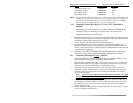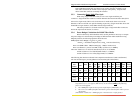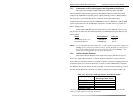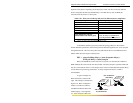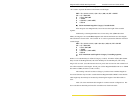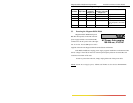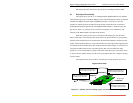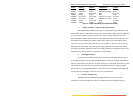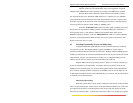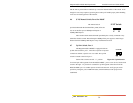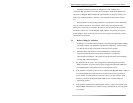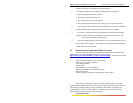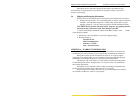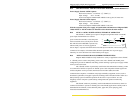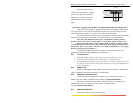
Magnum DS50 / DS60s Dual Speed Hubs Installation and User Guide (06/02)
4.2 Auto-negotiation and speed-sensing
The first five RJ-45 ports independently support auto-negotiation for shared
10BASE-T and 100BASE-TX modes. Operation is according to the IEEE 802.3u standard.
When an RJ-45 cable connection is made and each time a LINK is enabled,
auto-negotiation takes place. The DS50 / DS60 advertises it’s capability for 10 or 100Mbps
speed, and the device at the other end of the cable should similarly advertise / respond. Then
both sides will agree to the speed to be used. Depending upon the device connected, this will
result in agreement to operate at either 10Mbps or 100Mbps speed.
When the ‘10 M LINK/ACT’ LED is ON, either steady or blinking (see below),
the port has auto-negotiated for 10Mbps operation. (If a DS50 / DS60 port is connected to a
non-negotiating device, it will default to 10Mbps speed and half-duplex mode, per the
IEEE802.3 standard). Similarly, when the ‘100M LINK/ACT’ LED is lit, it means 100Mbps
operation. Since Magnum DS50 / DS60 are hubs, they always operate in the shared or half-
duplex mode on first five (1-5) ports.
4.3 Switching Functionality for port # 6 (DS60s Only)
A Magnum DS60 Dual-speed Hub Plus provides switched connectivity at Ethernet
wire-speed for port #6. The Magnum DS60C supports 10/100Mbs for copper media to
maximize bandwidth utilization and network performance. Similarly Magnum DS60F supports
100Mbps for Fiber media to maximize bandwidth utilization, network performance and secured
longer distance. All ports can communicate to all other ports in a Magnum DS60, but local
traffic on port #6 will not consume any of the bandwidth on any other port.
Magnum DS60 units are plug-and-play devices. There is no software configuring to
be done at installation or for maintenance. Full duplex and Auto-negotiation mode at 10 or
100Mbps for the switched copper port can be done through the manual switch underneath the
port it controls. Similarly the Fiber switched port at 100Mbps can be set at Full duplex as well
as Half-duplex through the manual switch underneath the port it controls. The internal functions
of switched port are described below.
Filtering and Forwarding
Each time a packet arrives on one of the switched ports, the decision is taken to either
filter or to forward the packet. Packets whose source and destination addresses are on the same
port segment will be filtered, constraining them to that one port and relieving the rest of the
network from processing them. A packet whose destination address is on another port segment
28
www GarrettCom com
..



